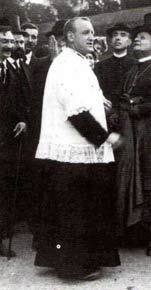Mosén Gil Parés i Vilasau (Barcelona 1880 - 1936)
Gil Parés i Vilasau was born in Barcelona on October 3, 1880 and was baptized on the 7th in the parish of Sant Francesc de Paòla.
He studied with the Jesuits and finished high school in 1898. Having a vocation for the priesthood, the following year, 1899, he joined the Barcelona Seminary.
In 1902 he became a catechist in the Crypt of the Sagrada Familia. There he met Gaudi, who treated him pleasantly; and they began, despite the age difference, a profound friendship.
On June 17, ember days of the Trinity in 1905, at 24 years of age, Gil Parés received priestly ordination. He sang the Mass on June 22, 1905, solemnity of the CorpusChristi, in the chapel of the Holy Trinity of Jesuit priests in Caspe street. The following Sunday, June 25th - and Gaudí´s fifty-third birthday -, he celebrated the Eucharist in the Crypt; and on the Monday took office as chaplain-custodian. He was the first chaplain-custodian of the Crypt; he had been appointed by the bishop of Barcelona, Cardinal Salvador Casañas i Pagès, who intended to convert the Temple of the Sagrada Familia into another parish of the city, against the wishes of Gaudi. Even so, Gaudi built a small house for the chaplain to live in.
Gil Parés was a very apostolic priest and in 1906 he founded in the Crypt the Apostolate of Prayer, the League of Perseverance, the Mary Congregation of Daughters of Mary, the Lyceum of the Sacred Family, etc.
In March 1907, Cardinal Casañas, following on with his idea, established the Crypt as suffragan tenure of the parish of St. Marti Porvençals and appointed Gil its chaplain Lieutenant. Back then, the only altar there was that of the chapel of St. Joseph. Gil asked to make a new one, in the most extensive area, to accommodate the growing number of parishioners attending. Gaudi was the first parishioner.
Gaudi contributed with a reproduction of the altarpiece that the sculptor Josep Llimona had made for the oratory of the Casa Batllo. Currently, this has been substituted for the original one of the Casa Batllo, which has been recovered and is now the main altarpiece of the Crypt. Both chaplain and architect collaborated with enthusiasm to make the ceremonies of the Crypt perfect models of the Catholic liturgy, with all their beauty, symbolic wealth and communicative splendour. Gaudi carefully designed the architecture, decoration, furniture and liturgical objects for this purpose. They introduced Gregorian chant and commissioned an organ from the Collbató builders, which was not finished until 1927.
After Tragic Week, in the summer of 1909, Gil suggested to Gaudí that they set up some schools for the children of the neighbourhood that had begun developing around the Temple. Gaudi designed and built a masterpiece and Gil was the director until 1930. Initially, it followed the pedagogical teaching methods of Father Manjón (1846-1923), founder of the Ave Maria Schools in Granada. A few years later, in 1915, the Montessori method was applied.
Gil was appointed Vice-Chairman of the Board of Works by the new bishop of Barcelona, Monsignor Enric Reig i Casanova. He remained so from 1916 until the death of Gaudi.
In 1924, Gil travelled to Rome. The Pope gave a special blessing for Gaudi and for all the workers and parishioners of the Sagrada Familia. In 1928, he repeated the journey.
Gil - whose ideas were moderately republican and in favour of the freedom of the catalan nation - had become for Gaudi a beloved friend, in whom he also had full confidence. Thus, the architect appointed him as executor of his will. When Gaudi died, Gil handled everything.
Four years passed and during the feast of Corpus Christi, June 29, 1930, in the neighbourhood procession, the Blessed Sacrament was carried aloft under canopy preceded by the great Catalan flag that Gaudi had designed for this purpose. This had not happened since 1923, when the coup d´etat of General Primo de Rivera had launched an anti-catalan military dictatorship, a copy of the Italian fascism of Mussolini. Indeed, the dictatorship had pressured the Vatican to appoint as bishop of Barcelona one of the champions of hatred against the Catalans, their language and their national symbols: Monsignor Manuel Irurita, who arrived at the diocese on May 16, 1930. He discharged Gil of all his responsibilities in the Sagrada Familia and sent him, as attaché, to the Salesians of the Sant Joan promenade. When leaving the Sagrada Familia, Gil took with him Gaudí´s books and a small carving of St. Benedict. He would never return again.
On July 19, 1936 a wave of violent persecution against Catholics was unleashed, the most bloodthirsty in the history of Catalonia. Catholic Priests were murdered with impunity due to hatred of the Christian faith, as were those who hid them or provided them with any form of assistance. On Saturday, July 25, a patrol was sent to find Gil at the apartment of the School teacher, Maria Consolació Puig i Querol, at 325 Mallorca street, where he lived. They didn´t find him because he was hidden in another apartment, that of Mr. Coll i Clodomir Ibañez. The militiamen returned at around ten o clock to search all floors of the building. Gil gave himself up, hoping to thereby avoid more deaths. All three were taken and assasinated at dawn, behind the St. Pau Hospital.
Josep Maria Tarragona
|
 |
|